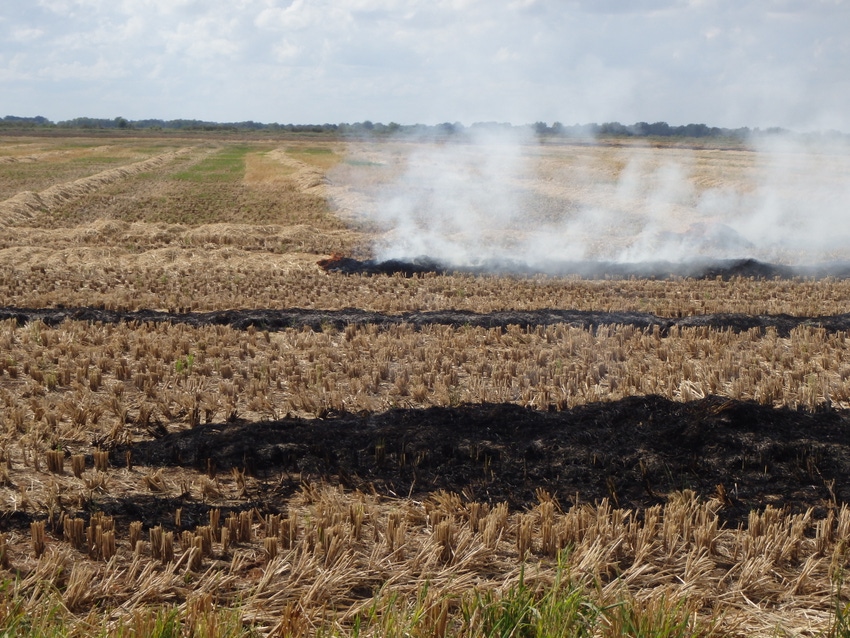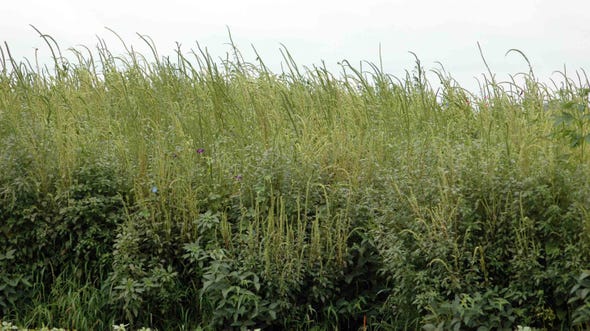
Think DifferentGet extreme with weed control:• Don't rely solely on herbicides.• Scout fields for control failure locations.• Pull weeds by hand and harvest last, till last and plant last.• Consider windrowing combine residue for burning and one-time moldboard plowing for extreme infestations.
July 27, 2016

It may be later than you think, if you believe you have time to control herbicide-resistant weeds.
"For extreme diseases, extreme methods of cure, as to restriction, are most suitable," said Greek physician Hippocrates (460-370 BC).
Truer words could not be spoken when it come to Palmer Amaranth. And things don't get much more extreme than destroying knee-high soybeans, but that's what Perry Galloway did this summer. The Arkansas farmer who topped state yields with 108 bushels in 2015 saw Palmer Amaranth overrun two fields this year.
"We've got DNA, ALS, glyphosate and PPO resistant pigweed with glufosinate our only legal option," says Galloway. "We have to stack residuals with every application."
Jason Norsworthy, University of Arkansas weed scientist, says the Palmer amaranth problem in his state is so bad that it is time for extreme methods of weed control that do not rely on herbicides alone.

Herbicide resistant Palmer amaranth infestations like this leave growers with few options. Jason Norsworthy, University of Arkansas weed scientist, suggests considering burning harvest residue in narrow windrows to destroy the majority of mature seeds and moldboard plowing the field. Growers like Perry Galloway fears even these extreme measure will be insufficient. Credit: Univ. of Illinois
Fear that farmers won’t act
"We won't spray our way out of this problem," says Norsworthy. "Until we bring cultural methods such as cultivation, burning and deep tillage back into the system, crop production won't be sustainable in the long term."
Norsworthy fears growers won't adopt such solutions until their backs are against the wall. This year's explosion of Palmer amaranth may have pushed them there. He describes fields that are being hand weeded and others, like Galloway's, terminated. In one part of the state growers have banded together in a multi-year strategy to allow zero weeds in all fields, as well as in roadside ditches. Meanwhile, Norsworthy and his colleagues have developed and promoted a strategy of windrowing and burning soybean chaff to no avail...until this year.
"Most of the calls to our offices this summer have been on how to build a chute to make the narrow windrows," he says.
The concept is simple. A home-built, V-shaped chute that narrows from the discharge throat to an 18-in. wide opening gathers and windrows the soybean trash along with harvested weed seeds. Norsworthy's research has demonstrated how effective burning the trash can be.
Burning combine residue, seriously
"The windrow can burn for five to six minutes and get above 450° Celsius (842° F)," he says. "We've had 100 percent control of all Palmer amaranth, barnyardgrass and johnsongrass seed present."
Chaff and weed seeds in this Arkansas rice field have been confined to a narrow windrow for burning. It is one of a multi-tool effort for reducing weed seed distribution in soybean fields, advocated by University of Arkansas weed scientist, Jason Norsworthy. Heat can reach in excess of 800° F. reducing weed seeds to ashes. Credit: Jarrod Hardke, University of Arkansas
This, too, is a multi-year strategy, reducing escaped Palmer amaranth by 73 percent and reducing the soil seed bank by 62 percent after three successive years of burning. Norsworthy advocates combining burning with moldboard plowing to bury weed seeds 8 to 10 inches deep, followed by cover crops.
"One-time use of a moldboard plow can reduce Palmer emergence by 75 to 80 percent," he says. "Come back with a cover crop like cereal rye, and you reduce emergence 90 percent."
In addition to rye's allelopathy, the mulch left when it is terminated reduces the daily temperature fluctuations at the soil surface. Norsworthy explains that temperature fluctuations signal weed seeds that conditions are right to germinate.
"The ideal situation is to burn, plow and then move to zero tolerance with cultural controls," says Norsworthy.
Waterhemp threat climbing
While the threat of widespread failure is less ominous in Iowa than Arkansas, farmers there face potentially similar problems with waterhemp. Mike Owen, Iowa State University agronomy professor and extension weed scientist, estimates 50 percent of Iowa fields have some waterhemp resistant to Group 2 (ALS inhibitors) and Group 14 (PPO inhibitors) herbicides. As yet, most resistance is a matter of a few waterhemp in a field going to seed, with an estimated 18 percent of waterhemp in the state PPO resistant.
"If farmers would cultivate or hand pull them, they could manage resistance pretty effectively," he says. "If they don't, the whole ball of yarn will come unraveled. We've seen fields this year that are going to suffer harvest losses and difficulty combining."

These waterhemp survivors suspected to be glyphosate resistant could have been eliminated easily earlier in the season. Run through a combine, they will likely spread throughout this field as well as to other fields and even other farms. Mike Owen, agronomy professor and extension weed scientist, Iowa State University, recommends isolating problem areas and schedule them for end of season harvest. Credit: Iowa State University
While mechanical or even hand cultivation could make a difference, Owen says just the idea makes farmers' eyes glaze over. "They think of cultivating every acre every year," he says. "I'm talking about certain fields, or even areas in a field, profiting from some supplemental cultivation."
Owen advocates site-specific, Integrated Weed Management, rotating herbicide groups, using multiple groups with effective modes of action, using appropriate tillage and adding cover crops. He emphasizes reducing weed seed transfer between fields. That includes scheduling fieldwork according to weed pressure and not combining weedy areas.
Harvest weedy spots and fields last
"If a problem is in a particular field, isolate it," he says. "Till it last, plant it last and harvest it last so you don't carry seed over into the next field. Manage weeds in the headlands, field margins, ditches and right of ways. If you do enough little things, you can end up with pretty good control."
Back in Arkansas, Galloway, with 125 acres of freshly disked soybeans, questions if it isn't too late for these measures in his fields and others fighting Palmer. With one surviving plant able to release up to a million seeds, 75, 80 or even 95 percent control may not be enough. He suspects that seeds shattered at the cutter bar on the combine will outweigh the benefit of burning. Using hand labor on escapes the past four to five years wasn't enough, and he fears cultivation will just bring more seeds to the surface.
"We have such a massive seed bank, I don't believe even moldboard plowing is the answer," says Galloway. "I don't know what the answer is. All I can do is hope and pray that glufosinate lasts a few more seasons until another technology is approved and that there are more technologies behind that."
About the Author(s)
You May Also Like



